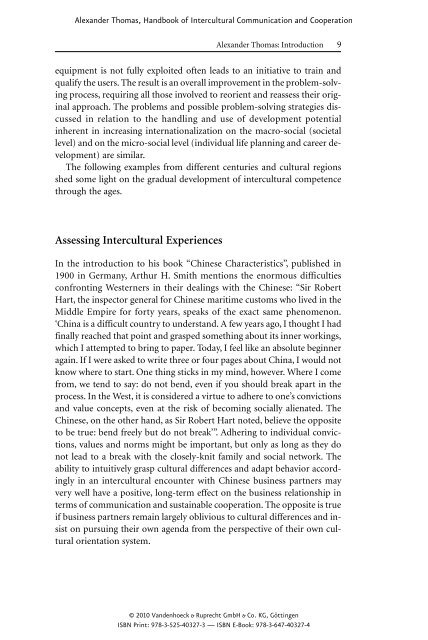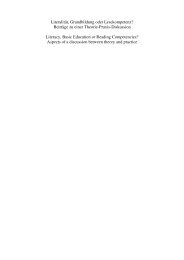Handbook of Intercultural Communication and ... - E-cademic
Handbook of Intercultural Communication and ... - E-cademic
Handbook of Intercultural Communication and ... - E-cademic
Create successful ePaper yourself
Turn your PDF publications into a flip-book with our unique Google optimized e-Paper software.
Alex<strong>and</strong>er Thomas, <strong>H<strong>and</strong>book</strong> <strong>of</strong> <strong>Intercultural</strong> <strong>Communication</strong> <strong>and</strong> Cooperation<br />
equipment is not fully exploited <strong>of</strong>ten leads to an initiative to train <strong>and</strong><br />
qualify the users. The result is an overall improvement in the problem-solving<br />
process, requiring all those involved to reorient <strong>and</strong> reassess their original<br />
approach. The problems <strong>and</strong> possible problem-solving strategies discussed<br />
in relation to the h<strong>and</strong>ling <strong>and</strong> use <strong>of</strong> development potential<br />
inherent in increasing internationalization on the macro-social (societal<br />
level) <strong>and</strong> on the micro-social level (individual life planning <strong>and</strong> career development)<br />
are similar.<br />
The following examples from different centuries <strong>and</strong> cultural regions<br />
shed some light on the gradual development <strong>of</strong> intercultural competence<br />
through the ages.<br />
Assessing <strong>Intercultural</strong> Experiences<br />
Alex<strong>and</strong>er Thomas: Introduction 9<br />
In the introduction to his book “Chinese Characteristics”, published in<br />
1900 in Germany, Arthur H. Smith mentions the enormous difficulties<br />
confronting Westerners in their dealings with the Chinese: “Sir Robert<br />
Hart, the inspector general for Chinese maritime customs who lived in the<br />
Middle Empire for forty years, speaks <strong>of</strong> the exact same phenomenon.<br />
‘China is a difficult country to underst<strong>and</strong>. A few years ago, I thought I had<br />
finally reached that point <strong>and</strong> grasped something about its inner workings,<br />
which I attempted to bring to paper. Today, I feel like an absolute beginner<br />
again. If I were asked to write three or four pages about China, I would not<br />
know where to start. One thing sticks in my mind, however. Where I come<br />
from, we tend to say: do not bend, even if you should break apart in the<br />
process. In the West, it is considered a virtue to adhere to one’s convictions<br />
<strong>and</strong> value concepts, even at the risk <strong>of</strong> becoming socially alienated. The<br />
Chinese, on the other h<strong>and</strong>, as Sir Robert Hart noted, believe the opposite<br />
to be true: bend freely but do not break’”. Adhering to individual convictions,<br />
values <strong>and</strong> norms might be important, but only as long as they do<br />
not lead to a break with the closely-knit family <strong>and</strong> social network. The<br />
ability to intuitively grasp cultural differences <strong>and</strong> adapt behavior accordingly<br />
in an intercultural encounter with Chinese business partners may<br />
very well have a positive, long-term effect on the business relationship in<br />
terms <strong>of</strong> communication <strong>and</strong> sustainable cooperation. The opposite is true<br />
if business partners remain largely oblivious to cultural differences <strong>and</strong> insist<br />
on pursuing their own agenda from the perspective <strong>of</strong> their own cultural<br />
orientation system.<br />
© 2010 V<strong>and</strong>enhoeck & Ruprecht GmbH & Co. KG, Göttingen<br />
ISBN Print: 978-3-525-40327-3 — ISBN E-Book: 978-3-647-40327-4

















